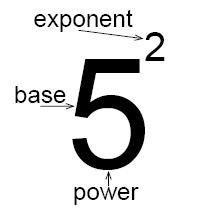Exponent :
Definition 1 :
Exponent is defined as the method of expressing large numbers
in terms of powers. That means, exponent refers to how many times a number
multiplied by itself. For example, 6 is multiplied by itself 4 times, i.e. 6 ×
6 × 6 × 6. This can be written as 64. Here, 4 is the exponent and 6 is the
base. This can be read as 6 is raised to power 4.
Exponent Symbol
The
symbol used for representing the exponent is ^. This symbol (^) is
called a carrot. For example, 4 raised to 2 can be written as 4^2 or 42. Thus,
4^2 = 4 × 4 = 16. The below table shows the representation of a few numerical
expressions using exponents.
Power
of Exponent :
A power is the product of multiplying a
number by itself.
Usually,
a power is represented with a base number and an
exponent. The base number tells what number
is being multiplied. The exponent, a small number
written above and to the right of the base number, tells how many times the
base number is being multiplied.
For
example, “6 to the 5th power” may be written as “65.” Here, the base
number is 6 and the exponent is 5. This means that 6 is being multiplied by
itself 5 times: 6 x 6 x 6 x 6 x 6
6 x 6 x 6
x 6 x 6 = 7,776 or 65 = 7,776
Definition
2 :An expression that represents repeated multiplication of the same factor is
called a power.
The number 5 is called the base, and the number 2 is called the
exponent. The exponent corresponds to the number of times the base is used as a
factor.

Definition 3 : Exponential
notation is a form of mathematical shorthand which allows us to write complicated
expressions more succinctly. An exponent is a number or letter written above
and to the right of a mathematical expression called the base. It
indicates that the base is to be raised to a certain power. x is the base
and n is the exponent or power.
Definition: If x is a positive number and n is its exponent,
then xn means x is multiplied by itself n times.
Laws
of Exponent :
Examples
of Exponent :
Write these multiplications like exponents
Example 2
Example 3 :
Multiplication
If two powers have the same base then we can multiply the powers.
When we multiply two powers we add their exponents.
The rule:
Example
A negative exponent is the same as the reciprocal of the positive
exponent.
When you raise a product to a power you raise each factor with a
power
Example
Basic rules for exponentiation
If n is a positive integer and x is any real number, then xn corresponds to
repeated multiplication
We can call this “x raised
to the power of n,” “x to the power of n,” or simply “x to
the n.” Here, x is the base and n
is the exponent or the power.
From this definition, we can deduce some basic rules that
exponentiation must follow as well as some hand special cases that
follow from the rules. In the process, we'll define exponentials xa
for exponents a that
aren't positive integers.
We can call this “x raised
to the power of n,” “x to the power of n,” or simply “x to
the n.” Here, x is the base and n
is the exponent or the power.
From this definition, we can deduce some basic rules that
exponentiation must follow as well as some hand special cases that
follow from the rules. In the process, we'll define exponentials xa
for exponents a that
aren't positive integers.
Product of exponentials with same base
If
we take the product of two exponentials with the same base, we simply add the
exponents:
If
we take the product of two exponentials with the same base, we simply add the
exponents:













No comments:
Post a Comment